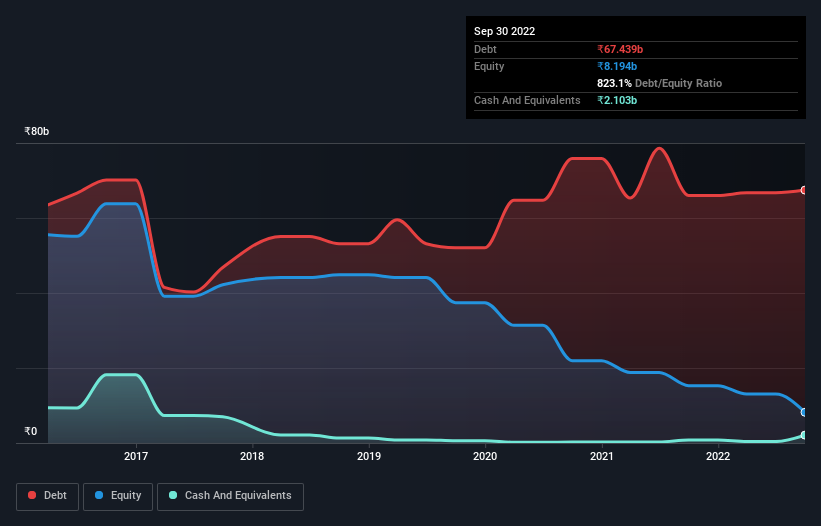[ad_1]
Howard Marks put it nicely when he said that, rather than worrying about share price volatility, ‘The possibility of permanent loss is the risk I worry about… and every practical investor I know worries about.’ So it might be obvious that you need to consider debt, when you think about how risky any given stock is, because too much debt can sink a company. We can see that Sintex Industries Limited (NSE:SINTEX) does use debt in its business. But is this debt a concern to shareholders?
Why Does Debt Bring Risk?
Generally speaking, debt only becomes a real problem when a company can’t easily pay it off, either by raising capital or with its own cash flow. Part and parcel of capitalism is the process of ‘creative destruction’ where failed businesses are mercilessly liquidated by their bankers. However, a more common (but still painful) scenario is that it has to raise new equity capital at a low price, thus permanently diluting shareholders. Of course, plenty of companies use debt to fund growth, without any negative consequences. When we think about a company’s use of debt, we first look at cash and debt together.
See our latest analysis for Sintex Industries
What Is Sintex Industries’s Net Debt?
As you can see below, Sintex Industries had ₹67.4b of debt, at September 2022, which is about the same as the year before. You can click the chart for greater detail. On the flip side, it has ₹2.10b in cash leading to net debt of about ₹65.3b.

A Look At Sintex Industries’ Liabilities
We can see from the most recent balance sheet that Sintex Industries had liabilities of ₹92.9b falling due within a year, and liabilities of ₹23.8m due beyond that. On the other hand, it had cash of ₹2.10b and ₹2.82b worth of receivables due within a year. So its liabilities outweigh the sum of its cash and (near-term) receivables by ₹88.0b.
The deficiency here weighs heavily on the ₹2.20b company itself, as if a child were struggling under the weight of an enormous back-pack full of books, his sports gear, and a trumpet. So we’d watch its balance sheet closely, without a doubt. After all, Sintex Industries would likely require a major re-capitalisation if it had to pay its creditors today.
We measure a company’s debt load relative to its earnings power by looking at its net debt divided by its earnings before interest, tax, depreciation, and amortization (EBITDA) and by calculating how easily its earnings before interest and tax (EBIT) cover its interest expense (interest cover). Thus we consider debt relative to earnings both with and without depreciation and amortization expenses.
Sintex Industries shareholders face the double whammy of a high net debt to EBITDA ratio (15.9), and fairly weak interest coverage, since EBIT is just 0.17 times the interest expense. This means we’d consider it to have a heavy debt load. Looking on the bright side, Sintex Industries boosted its EBIT by a silky 50% in the last year. Like the milk of human kindness that sort of growth increases resilience, making the company more capable of managing debt. When analysing debt levels, the balance sheet is the obvious place to start. But you can’t view debt in total isolation; since Sintex Industries will need earnings to service that debt. So if you’re keen to discover more about its earnings, it might be worth checking out this graph of its long term earnings trend.
Finally, a company can only pay off debt with cold hard cash, not accounting profits. So we always check how much of that EBIT is translated into free cash flow. Over the last two years, Sintex Industries recorded free cash flow worth a fulsome 89% of its EBIT, which is stronger than we’d usually expect. That puts it in a very strong position to pay down debt.
Our View
On the face of it, Sintex Industries’s interest cover left us tentative about the stock, and its level of total liabilities was no more enticing than the one empty restaurant on the busiest night of the year. But at least it’s pretty decent at converting EBIT to free cash flow; that’s encouraging. Once we consider all the factors above, together, it seems to us that Sintex Industries’s debt is making it a bit risky. Some people like that sort of risk, but we’re mindful of the potential pitfalls, so we’d probably prefer it carry less debt. When analysing debt levels, the balance sheet is the obvious place to start. But ultimately, every company can contain risks that exist outside of the balance sheet. To that end, you should learn about the 3 warning signs we’ve spotted with Sintex Industries (including 2 which are significant) .
When all is said and done, sometimes its easier to focus on companies that don’t even need debt. Readers can access a list of growth stocks with zero net debt 100% free, right now.
Valuation is complex, but we’re helping make it simple.
Find out whether Sintex Industries is potentially over or undervalued by checking out our comprehensive analysis, which includes fair value estimates, risks and warnings, dividends, insider transactions and financial health.
View the Free Analysis
Have feedback on this article? Concerned about the content? Get in touch with us directly. Alternatively, email editorial-team (at) simplywallst.com.
This article by Simply Wall St is general in nature. We provide commentary based on historical data and analyst forecasts only using an unbiased methodology and our articles are not intended to be financial advice. It does not constitute a recommendation to buy or sell any stock, and does not take account of your objectives, or your financial situation. We aim to bring you long-term focused analysis driven by fundamental data. Note that our analysis may not factor in the latest price-sensitive company announcements or qualitative material. Simply Wall St has no position in any stocks mentioned.
[ad_2]
Source link








